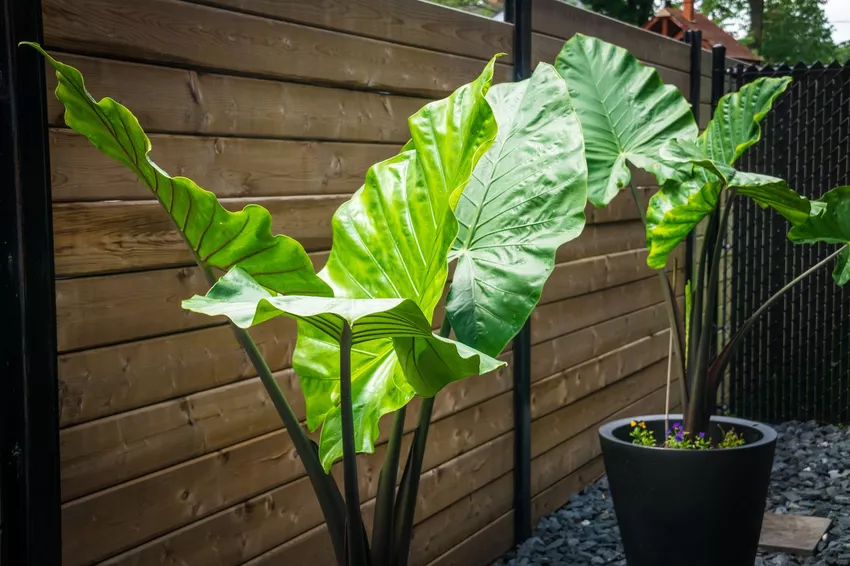The elephant ear plant forms leaves with an area of up to one square meter. This is a considerable size, especially for indoor plants.

Where the name of the elephant ear (Alocasia macrorrhyzos) comes from is obvious at first glance. Such an imposing plant requires a lot of space in the room. Here we show you what else you should consider when planting and the location.
Elephant ear: flower, origin and properties
Confusion can sometimes arise when it comes to elephant ear plants, because there are various indoor plants that are called and offered as elephant ear plants. Most belong to the genus of arrowhead (Alocasia) - including the giant-leaved arrowhead (Alocasia macrorrhyzos) from tropical Asia article goes. In addition to the name elephant ear, the beautiful houseplant also bears the name giant taro or simply alocasia. In addition to Alocasia macrorrhyzos, Haemanthus albiflos and Kalanchoë are referred to as elephant ear plants. beharensis. The plants look completely different and even belong to different genera and plant families.

The giant arrowhead is not only widespread as a houseplant, but is also cultivated as a crop in tropical regions. When cooked, the rhizome can be used as food. The elephant ear, which belongs to the Araceae family, has leaves with a diameter of up to one meter. The petioles arise from the thick, upright rhizome. The green leaves are arrow or heart shaped with a smooth or slightly wavy edge. Overall, the elephant ear reaches a size of up to 2 m as a houseplant - in nature it can sometimes be up to 8 m. The elephant ear flower consists of a bulbous inflorescence in white or light yellow and is surrounded by a light green bract, the spathe. In indoor plants, however, it appears only extremely rarely. After pollination, red spherical ones formBerries.
Tip: It is normal for the leaves of the elephant ear plant to drip. It's called guttation. Especially when the humidity is high, the plant releases plant sap through the leaves.
The most beautiful varieties of elephant ear
The giant-leaved arrowhead is not particularly common as an ornamental plant in the room. Last but not least, because a certain amount of space is required for posture. Accordingly, the selection of elephant ear varieties is still quite clear.

- Alocasia macrorrhyzos 'Variegata': The green leaves of this variety are variegated with white, which looks particularly impressive on the large leaf surface.
- Alocasia macrorrhyzos 'Lutea': The Golden Elephant's Ear has golden green petioles and veins, which contrasts nicely with the green leaf surface .
- Alocasia macrorrhyzos 'New Guinea Gold': This is a gold and green variegated variety.
Plant Elephant Ear
Based on the conditions in the tropical rainforest, the elephant ear likes a bright location in the light penumbra in a warm, humid environment. Direct sun should be avoided, as should temperatures below 15°C. This also applies in winter. The elephant ear tolerates room temperatures of 20 - 25 °C all year round. Increased humidity can be achieved by regularly spraying the leaves. In addition to the right location, proper care of the elephant ear is necessary for the plant to develop well.
Tip: Elephant ear plants are not only available ready-made in specialist shops. You can also grow them yourself from seed, or make two from one elephant's ear by dividing the rhizome of the mother plant.

Elephant ear as a houseplant
If the elephant's ear is kept as a houseplant, a sufficiently large pot is important. The plant forms thick rhizomes and grows up to 2 m tall. In addition, the elephant ear develops enormous leaves. It is therefore important to provide stability for the Alocasia in a large, heavy pot. The pot must have a drainage hole to allow excess water to drain. The elephant ear does not tolerate waterlogging. It is best to also lay a drainage layer of pebbles toto protect elephant ear from root rot.
Which soil is suitable for the elephant ear? Soil with a high nutrient content and humus content and a slightly acidic pH value is suitable for the elephant ear. A loose, permeable structure is also important. Our Plantura organic universal soil, for example, combines all of these properties. It remains structurally stable for a long time, which supports root growth, and supplies the plant with all the important nutrients for at least three months. It does so entirely without peat.
Elephant ear in the garden
In the summer, the elephant ear can also go outside in the garden. However, the elephant ear should also be outside in the pot and not planted directly in the garden soil. In early autumn, the plant gets too cold in our latitudes and has to be brought indoors. The elephant ear does not tolerate temperatures below 15 °C. A sheltered, partially shaded location is also essential in the garden. It is best when there is high humidity. For this reason, it makes sense to keep the elephant ear indoors, especially during the particularly dry summer months. High humidity can be achieved far better here than outside.

Is the elephant ear plant poisonous?
Yes, the elephant ear plant is poisonous due to the milky sap it contains. The juice irritates skin and mucous membranes on contact, which is why gloves should be worn when handling the plant to be on the safe side. Because elephant ear is also poisonous to cats and dogs, the plant is best kept out of the reach of pets.
Note: In Asia, the rhizome of the elephant ear plant is cooked and consumed. However, since some species of the genus Alocasia are also intolerant when cooked and some species look confusingly similar, eating the houseplant is strongly discouraged.
Another representative of the arrowhead is the Alocasia zebrina. It is particularly popular as a houseplant because of its unusual markings on the stem.